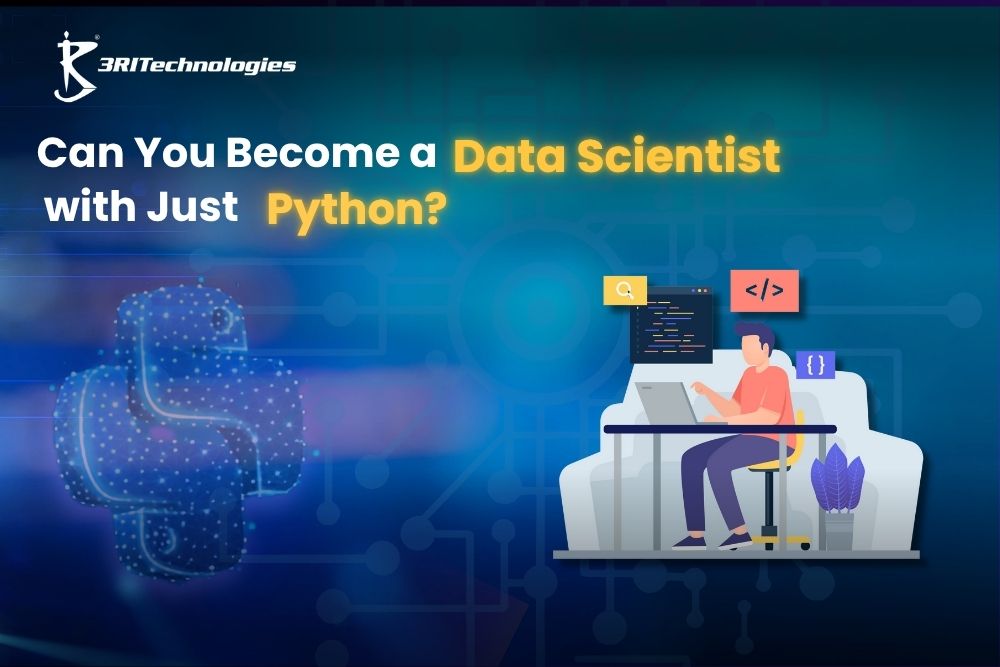One of the most profitable and sought-after job choices in the age of data-driven decision-making is data science. Many aspiring professionals often wonder, “Can I become a data scientist with just Python?” Python has emerged as the preferred programming language for data science because of its ease of use, plenty of libraries, and strong community support, making this topic particularly pertinent. Keywords like learn Python for data science, Python data science course, and data scientist with Python dominate search engines, underscoring the demand for clarity around this topic.
While Python is undoubtedly a powerful tool, becoming a data scientist involves more than just writing scripts. In this blog, we’ll dissect the reality behind relying solely on Python for a data science career. We’ll explore what Python can do, what it can’t, and what additional skills and tools complement it to build a strong data science portfolio. By the end, you’ll know where Python stands in the data science ecosystem and what your next steps should be.
What Makes Python the Preferred Language in Data Science?
Simplicity and Readability: Beginners may easily learn Python because to its clear and simple syntax. Data scientists may concentrate more on resolving data issues rather than fumbling with code because of its ease.
Extensive Libraries and Frameworks: Python offers an impressive suite of libraries for data science:
| Library | Purpose |
| NumPy | Numerical computations |
| Pandas | Data manipulation and analysis |
| Matplotlib/Seaborn | Data visualization |
| Scikit-learn | Machine learning |
| TensorFlow/Keras | Deep learning |
These libraries enable professionals to perform tasks ranging from data wrangling to model training with relative ease.
Community and Open Source Support: Python boasts a large and vibrant community that answers questions on sites like Stack Overflow, adds to libraries, and offers free educational materials. This ensures faster learning and troubleshooting.
The Core Areas of Data Science Beyond Python
While Python is central to data science, it’s just one part of a bigger puzzle. Let’s dissect the key elements you must become proficient in:
1. Mathematics and Statistics
Behind every machine learning model lies solid math. Key concepts in probability, linear algebra, and statistics help you understand how algorithms work and why they behave the way they do. Knowing how to calculate distributions, variances, correlations, or eigenvalues allows you to not just apply models, but also interpret and troubleshoot them effectively.
2. Data Manipulation and Cleaning
In the real world, data is rarely clean or usable. While Python libraries like Pandas and NumPy assist, mastering techniques like dealing with missing values, standardizing formats, and detecting outliers is vital. The success of any analysis or model often depends more on data preparation than the algorithm itself.
3. Machine Learning Algorithms
Tools like Scikit-learn let you apply ML models with just a few lines of code, but true skill lies in understanding their mechanics. You should know how linear regression, decision trees, K-means, and ensemble methods work, including their assumptions and limitations. This knowledge helps you select the right algorithm for the right problem and fine-tune it for better performance.
4. Data Visualization
Conveying insights clearly is as important as deriving them. Libraries such as Matplotlib, Seaborn, and Plotly enable beautiful and interactive charts, but it’s your ability to tell a compelling data story that creates impact. Visualization facilitates the conversion of complicated facts into narratives that can be put into action, whether you’re drafting a report or presenting to stakeholders.
5. Domain Knowledge
Technical skills alone won’t make you a great data scientist—business understanding is equally crucial. Knowing the industry context helps you ask the right questions, interpret results meaningfully, and deliver insights that truly matter. Having domain expertise makes your data science job more useful and focused, regardless of the industry—healthcare, banking, or e-commerce.
Python Alone: What You Can and Cannot Do
What You Can Do with Just Python:
- Analyze datasets using Pandas and NumPy
- Create visualizations with Seaborn and Matplotlib
- Implement basic machine learning models
- Automate data pipelines
- Perform web scraping using libraries like BeautifulSoup or Scrapy
What You Cannot Do with Just Python:
- Build robust data pipelines without SQL knowledge
- Deploy models without understanding DevOps or MLOps concepts
- Interpret results accurately without statistics
- Work efficiently with big data without Hadoop or Spark
Pro Tip: While Python can get you started, integrating tools like SQL, Power BI, or cloud platforms like AWS enhances your capabilities.
A Sample Data Science Workflow Using Python
graph TD
A[Data Collection] –> B[Data Cleaning with Pandas]
B –> C[Exploratory Data Analysis with Seaborn]
C –> D[Model Building with Scikit-Learn]
D –> E[Model Evaluation]
E –> F[Report Generation]
This diagram shows that while each step can be done using Python, domain knowledge and analytical thinking are needed at every level.
Table: Skills Comparison – Python vs Other Tools
| Task | Python | Required Add-on |
| Data Cleaning | Yes | Pandas |
| Data Visualization | Yes | Seaborn, Matplotlib |
| SQL Querying | No | SQL |
| Big Data Processing | Limited | PySpark, Hadoop |
| Model Deployment | Limited | Flask, Docker, Cloud platforms |
Why Learning Only Python May Limit Your Growth
1. Competitive Job Market
In today’s job landscape, employers seek professionals with a diverse tech stack. While Python is essential, it’s rarely enough on its own. Most data-related roles require proficiency in SQL for database queries, cloud platforms like AWS or Azure, and sometimes BI tools or machine learning frameworks. Relying only on Python may leave you underqualified for many high-value roles in data science and analytics.
2. Incomplete Problem Solving
Real-world data problems are complex and rarely solved with code alone. A strong grip on statistics, domain knowledge, and business context is necessary to draw actionable insights. Additionally, understanding data engineering principles—like data pipelines and storage—helps you handle messy, large-scale datasets. Python can process data, but without these complementary skills, your solutions may lack depth and precision.
3. Evolving Technologies
With the quick emergence of new tools, libraries, and frameworks, the IT environment is always evolving. Limiting yourself to Python alone may make it harder to adapt when companies shift to newer technologies. For instance, tools like Apache Spark, dbt, or AutoML platforms are becoming standard in some data workflows. Staying current with the broader tech stack ensures you remain relevant and competitive in a fast-moving industry.
How to Effectively Learn Python for Data Science
Step-by-Step Learning Path
1. Start with the Basics
Learn the basics of Python programming to start your adventure. This includes understanding its syntax, writing clean code, and using control structures like loops and conditionals to manage the flow of logic. Mastering functions and core data structures like lists, dictionaries, and sets is also crucial. These abilities serve as the foundation for any subsequent data-related tasks you do.
What to Learn:
- Python Syntax: Learn how Python code is structured—indentation, variables, data types, and operators.
- Control Structures:
- Loops: for, while loops for iteration.
- Conditionals: if, else, and elif statements to make decisions.
- Functions: How to write reusable code using def, pass arguments, and return values.
- Data structures: dictionaries, sets, lists, tuples, and when to use each.
Why It Matters:
These basics form the core of any script or data workflow. Without them, it’s impossible to understand or write efficient data analysis or machine learning code.
2. Explore Essential Libraries
Once you’re comfortable with the basics, start exploring Python libraries tailored for data science. Learn how to manipulate and analyze data with Pandas and perform numerical calculations using NumPy. For visualization, get hands-on with Matplotlib and Seaborn, which help you present insights through plots and graphs. These libraries streamline the entire data workflow, making it easier to handle real-world datasets efficiently.
Key Libraries to Master:
- NumPy: Used for numerical computations, working with arrays, and linear algebra.
- Pandas: Use DataFrame and Series, clean, and wrangle data; vital for data analysis and manipulation.
- Matplotlib & Seaborn: Data visualization tools to create insightful charts and graphs.
What to Practice:
- Reading and writing data (CSV, Excel, SQL).
- Cleaning messy datasets (handling nulls, filtering, transforming).
- Aggregation, merging, pivoting, and grouping data.
- Plotting trends, distributions, and correlations.
Why It Matters:
These packages serve as the foundation for Python data analysis. Before using any machine learning techniques, you will utilize them on a regular basis to prepare, examine, and visualize data.
3. Practice with Real Projects
Real-world projects provide the ideal opportunity to reinforce what you have learned. Take part in contests or investigate data sets that pique your interest by using websites such as Kaggle. Try to work on projects that involve data cleaning, exploration, and storytelling through visualizations. Hosting your code on GitHub also helps you track progress and share your work with the community or potential employers.
Where to Practice:
- Kaggle: Participate in beginner-friendly challenges and notebooks.
- GitHub: Explore open-source datasets, contribute to or fork repositories.
- Personal Projects: Analyze a dataset that interests you (e.g., movies, sports, finance).
What to Include:
- Data collection (APIs or scraping).
- Data cleaning and EDA (exploratory data analysis).
- Visualization and interpretation of findings.
Why It Matters:
Real-world projects give you confidence, reinforce concepts, and show you how to think like a data scientist. They also make your resume/portfolio stand out.
4. Study Machine Learning (ML)
After gaining confidence with data handling, transition into machine learning. Learn how to build and evaluate models using Scikit-learn, starting with linear regression and classification. Focus on essential concepts like cross-validation, model tuning, and overfitting. Making data-driven decisions in research or business requires an understanding of model training, testing, and improvement.
What to Learn:
- Scikit-learn (sklearn): Train regression, classification, and clustering models.
- Model evaluation: Make use of measures such as confusion matrix, RMSE, recall, accuracy, and precision.
- Cross-validation: Ensure your models generalize well by avoiding overfitting.
- Hyperparameter Tuning: Optimize your models with GridSearchCV or RandomSearch.
Why It Matters:
Machine learning is where you transform data insights into predictions and intelligence. This is crucial for roles like Data Scientist or ML Engineer.
5. Build a Strong Portfolio
Lastly, create an impressive portfolio to highlight your abilities. Upload your projects on GitHub with proper documentation and share your learning through blogs or LinkedIn posts. Describe the issue, your strategy, and the result. Having a well-organized portfolio not only reinforces your learning but also makes a strong impression on recruiters and hiring managers.
How to Do It:
- Upload Projects to GitHub: Keep code clean, documented, and version-controlled.
- Create Blogs or LinkedIn Posts: Explain what problem you solved, how, and your learnings.
- Use Platforms like Medium or Hashnode: Share data stories, tutorials, or model interpretations.
- Build a Portfolio Website: A central place for recruiters or collaborators to view your skills.
Why It Matters:
Recruiters and hiring managers look for proof of work. A portfolio helps you differentiate yourself from other applicants by showcasing your practical experience.
Real-World Use Cases Where Python Shines
1. Customer Churn Prediction
Using classification methods like logistic regression, decision trees, and random forests that are accessible in Scikit-learn, Python helps organizations anticipate client attrition. Businesses can identify consumers who are at danger of leaving by looking at past customer data, such as use trends, complaints, or payment history. This helps in taking proactive retention measures. Python’s flexibility and model evaluation tools make it ideal for churn modeling.
2. Sales Forecasting
Sales forecasting is critical for demand planning and inventory management. Python supports time series forecasting through libraries like statsmodels for ARIMA and Prophet by Facebook for more robust, interpretable models. By feeding in historical sales data, these models can predict future sales trends, seasonality, and anomalies. Python makes it easy to visualize, fine-tune, and automate the forecasting process.
3. Image Recognition
Python, with libraries like TensorFlow and Keras, is a go-to language for building convolutional neural networks (CNNs) used in image recognition. These models find extensive use in autonomous driving, object identification, medical imaging, and facial recognition. With GPU support and vast community resources, Python simplifies the development and deployment of powerful image classification systems.
4. Sentiment Analysis
Python’s NLP libraries, such as NLTK, SpaCy, and Hugging Face Transformers, allow data scientists to extract opinions and emotions from text data, particularly from sources like social media, reviews, and customer feedback. By performing tokenization, POS tagging, and classification, Python helps businesses understand public perception and customer sentiment. This insight aids in branding, customer service, and product development.
Learn Python first if you’re eager to start your career as a data scientist, but don’t stop there. Explore additional tools like SQL, statistics, and machine learning theory. At 3RI Technologies, we provide practical, industry-relevant courses that help close the knowledge gap between academia and practical applications.
Take the first step toward a fulfilling career in data science by enrolling now.
Conclusion: So, Is Python Enough?
Python is undoubtedly the backbone of data science, but it’s not the entire skeleton. While it’s possible to get started and even land entry-level roles with strong Python skills, you need a comprehensive skill set to thrive in the field.
To truly become a successful data scientist, pair Python with mathematical rigor, business acumen, and knowledge of supporting tools. Keep learning, stay curious, and embrace the multi-disciplinary nature of data science.
Are you curious about the steps involved in becoming a data scientist? Check out our complete Data Science Roadmap and plan your career smartly.
FAQ
Can I do data science with Python?
Yes, thanks to its many libraries like scikit-learn, Pandas, and NumPy, Python is one of the most widely used and potent languages for data research.
It’s widely used for data analysis, visualization, machine learning, and automation.
Are SQL and Python sufficient for data science?
Python and SQL are a strong foundation for data science, covering data manipulation, analysis, and querying. However, for advanced roles, knowledge of statistics, machine learning, and tools like Excel, Tableau, or Power BI can be valuable.
Is studying Python enough to land a job as a data scientist or developer?
Learning Python is a great start, but landing a job as a developer or data scientist typically also requires skills in problem-solving, data handling (like SQL), and domain-specific tools or libraries.Hands-on projects and practical experience greatly improve job prospects.
Can someone become a self-taught data scientist?
Yes, it’s realistic to become a self-taught data scientist with dedication, hands-on practice, and a strong grasp of tools like Python, SQL, and machine learning libraries. However, joining a reputable institute can accelerate your learning, provide structured guidance, and improve job readiness through mentorship and placement support.
How much Python does a data scientist need to know?
A data scientist needs to know enough Python to clean, analyze, and visualize data, build machine learning models, and automate tasks using libraries like Pandas, NumPy, Matplotlib, and scikit-learn.A strong grasp of real-world problem-solving using Python is more important than just syntax knowledge.
What language is needed for data science?
Python’s ease of use and extensive library ecosystem make it the most popular language in data research.SQL is also essential for data querying, and R can be useful for statistical analysis and academic research. R, Java, and Scala can also be useful depending on the specific domain or job role.
How much does a data scientist make?
Depending on geography, experience, and skill level, a data scientist’s pay in India usually varies between ₹6 LPA to ₹20+ LPA.Experienced experts can make much more money, whereas entry-level positions may start at ₹6–8 LPA.




